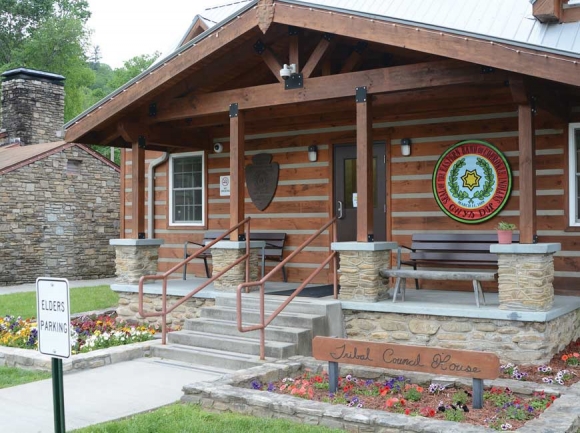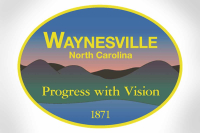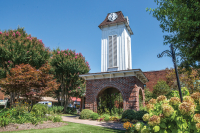One year later, Cherokee media ban still in effect
 Outside media representatives are allowed inside the Cherokee Council House, but not in the chamber where Tribal Council meets. Holly Kays photo
Outside media representatives are allowed inside the Cherokee Council House, but not in the chamber where Tribal Council meets. Holly Kays photo
Tribal Council got off to an unusual start in April of last year when Councilmember Tommye Saunooke, of Painttown, asked Tribal Council to begin the meeting by voting on a proposal that was absent from the day’s 28-item agenda.
“Mr. Chairman, at this time, I’d like to make a move that the only press allowed in our Cherokee chambers will be Cherokee press,” Saunooke said.
Chairman Adam Wachacha clarified that the term “Cherokee press” referred to Cherokee One Feather staff, and then Tribal Council took a vote — of the 12 members, only Councilmember Lisa Taylor, of Painttown, opposed the move.
One year in the rearview
April 5 marks the one-year anniversary of this action to restrict media access to the council chambers, and there seems to be little appetite among Tribal Council members to discuss a reversal.
“I haven’t heard anybody bring it up or discuss it,” said Principal Chief Richard Sneed. “There’s been silence on it. I don’t think anybody has given it much thought.”
Related Items
The Smoky Mountain News contacted all 12 Tribal Council members by phone and text message to request comment on this story. Of the 12, six did not return either the phone call or the text. Three answered the phone, said they could not talk at the moment, told the reporter when would be a good time to call back, but did not answer when the phone rang at the appointed time. One said he had a busy week and would attempt to give a response via text, but no text materialized. One hung up upon hearing who was making the call.
Only two councilmembers directly addressed their willingness to comment on the issue. Councilmember Perry Shell, of Big Cove, said that he appreciated the phone call but preferred not to comment. Councilmember Boyd Owle, of Birdtown, was the only representative to grant an interview on the topic. He said he regretted voting for the media ban.
“I think I might have made a hasty decision last time I voted,” he said. “I think that’s probably one of the votes I wish I could take back.”
Owle said he feels that way because there are many tribal members who live in the surrounding counties but not on tribal land. When media outlets other than The One Feather cover Tribal Council, those enrolled members are better able to know what’s going on in their government, he said, especially those who aren’t able to read news coverage online.
“It’s just a way of getting the word out there and news out there to the people that read paper, that don’t have computers or cell phones,” he said.
When asked his opinion on the topic, Sneed deferred to Tribal Council.
“It’s their decision. It’s not mine,” he said. “I can’t even really comment on it.”
“My personal thoughts are that I’m certainly a supporter of the free press,” he added after a follow-up question. “I have a respect for the press. I feel like the press is the fourth branch of government. It is the accountability mechanism for those of us who are in government. You should have access.”
Background on the ban
The April 5 vote in 2018 came two days after a Budget Council meeting in which Saunooke spoke more specifically about her reasons for requesting it.
“Chief, two things. I know there’s freedom of the press and freedom of speech and all that, but Tribal Council, I’m going to ask you to ask Holly (Kays) not to enter these chambers, because she called me the other day and said, ‘Can I quote you?’ and I said ‘No, don’t make me look ignorant,’” Saunooke said April 3, 2018, according to a video recording of the meeting. “She had a different quote from what I had said, but she did anyway. There’s an example of what she did. The Smoky Mountain News is not quoting us right, so I’m gonna ask Tribal Council if you’ll ask her to step out. That’d be my suggestion.”
Smoky Mountain News reporter Cory Vaillancourt examined Saunooke’s contention for an April 11, 2018, story in the paper. Vaillancourt concluded that “Saunooke’s allegations and her statement to council members were completely and verifiably incorrect.”
“Emails to and from Saunooke provided by (SMN reporter Holly) Kays show Kays wasn’t asking for Saunooke’s permission to use the quote, which is a matter of public record, even in Cherokee. Indeed, no such permission is ever necessary,” Vaillancourt wrote. “Instead, Kays — as a courtesy — was simply asking Saunooke if her statement was accurate and giving her a chance to elaborate on the point before the story went to print. ‘U made me sound ignorant with the statement .. I’m sure it was not phrased that way..’ Saunooke replied via email. The statement, however, was phrased exactly that way, per tribal video of the meeting.”
The legal basis
While the media ban prevents SMN — and all other media outlets aside from The Cherokee One Feather — from sitting in the council chambers, it does not necessarily preclude reporting on Tribal Council meetings. Council meetings are videotaped and broadcast live on local television and online. For the past year, SMN has sat in the lobby outside the council chambers, watching the meetings using earbuds and a laptop.
It’s not an ideal situation, but, said N.C. Press Association attorney Amanda Martin, access to video footage certainly is a valuable asset.
“I think that being able to hear what takes place gets a lot of what we need,” she said, “and by that I don’t mean to diminish the importance of physical access. But it seems that if you have the right to hear, you have it. I don’t think you should dismiss in your own reporting the significance of that.”
That said, there are certain nuances a reporter cannot capture without being in the room — facial expressions of people who aren’t on camera, the mood of the audience, or even statements made by council members who have forgotten to turn their mics on. Photography also becomes difficult to impossible.
“The One Feather is often in the office turning on the cable feed or the streaming and watching what goes on,” said Robert Jumper, editor of The Cherokee One Feather. “But there’s also times when there are presentations and signings inside the council chambers where you want to get a photograph or you want some video, or you want to see the reaction of people who may not be on camera.”
Under North Carolina law, it would be illegal to exclude a person — media or otherwise — from sitting in on a public meeting. However, state open meetings laws don’t apply in Cherokee. The Eastern Band of Cherokee Indians is a sovereign nation, and it has its own rules.
Constitutional protections do not apply on tribal land. Until 1968, when the Indian Civil Rights Act passed, tribal leaders had no responsibility to provide such protections. ICRA includes language similar to the Bill of Rights, including free speech and free press provisions, but enforcement can be difficult and judicial interpretation different than that under the First Amendment.
“Violations of ICRA must go to tribal court, and thus it is up to the tribal court to determine whether this is a violation of the free speech provisions of the act,” said Marcia Zug, professor of American Indian law at the University of South Carolina.
The tribe’s Free Press Act, passed in 2006, does speak specifically to the tribe’s adoption of ICRA and states that, “therefore, the principles of free speech and free press, the rights of the people to assemble and petition for redress of grievances shall not be abridged.” However, it then goes on to talk about an “Independent Free Press of the Eastern Band of Cherokee Indians” and then to specifically reference the tribal newspaper, The Cherokee One Feather, laying out the paper’s staffing and governance structure.
“You are, number one, on Indian land,” said Rusty McLean, a Waynesville attorney who has ample experience dealing with EBCI law. “So Tribal Council has full authority as a nation within a nation status to bar who they want to from their tribal government. Unless you get an invitation or you get an opportunity to have council invite you as a non-Indian media, they, believe it or not, have the right to do that.”
Whether something is legal is a different question than whether it’s advisable, however. McLean and Martin both said they considered it to be bad public policy to selectively shut members of the media out of government proceedings. The reason that it’s a bad idea, they said, has a lot more to do with the readers of the paper than with the staff who write it.
“Restricting access to areas involving matters of public concern by news outlets based on that news outlet’s viewpoint is concerning, because it doesn’t allow for readers to get multiple viewpoints and multiple perspectives,” agreed Nicole Ligon, supervising attorney and lecturing fellow at the Duke Law School First Amendment Clinic. “You’re limiting coverage to a singular perspective, which prevents readers from getting the full picture of what’s happening.”
Protest from The One Feather
The One Feather’s would be that “singular perspective” that Ligon referred to, but Jumper said that the exclusive access his paper now gets to the council chambers is a burden rather than a gift.
“There’s certainly a perception that since the tribe kind of owns its own paper that it also controls the content of the paper,” said Jumper. “And it doesn’t help a whole lot for The One Feather to be segregated from the rest of the media with regard to this particular ban.”
The One Feather is owned and funded by the tribal government. Its employees are tribal employees. While the paper has an editorial board to govern editorial decisions, advertising and operational structure, that board does not have hiring and firing authority. The paper has dealt with censorship issues before.
Over the past year, Tribal Council has passed legislation Jumper introduced to restructure appointments to the editorial board and to protect anonymous sources. However, Jumper said, there is still work to be done to make the paper truly independent.
Issues of independence aside, Jumper said, having coverage from multiple news sources is the best way to serve the people who consume that news.
“It’s always been important to me and to The One Feather staff that we not be the single voice telling the story of Cherokee,” he said. “It’s the media’s job as a unified whole. It’s the media’s job to document history and it’s not good benefit to the public and especially to the Cherokee community if one media outlet is the only voice in that documentation of history.”
The One Feather has been vocal in its opposition to the media ban, with both Jumper and former reporter Joe Martin penning multiple editorials over the last year calling it, among other things, “a stain on a free press” and “a step backward” for freedom of speech. In the next Tribal Council meeting following the ban, May 3, Jumper introduced a resolution that would have rescinded the ban. However, he withdrew the resolution following a conversation with Sneed about instead having a “meaningful discussion” about free press issues with various media outlets. Such a meeting was scheduled but then postponed and never rescheduled.
Jumper said that the paper is still interested in pursuing a change but that a written resolution might not be the best way to do it. The original move was made from the floor with no written document attached — a more informal request that Tribal Council consider shifting its position might be a better idea, he said.
Jumper is concerned as well with some unintended consequences of the ban.
“What happens when one of our Cherokee people who works for a different news organization wants to come in and report on Tribal Council?” he asked. “Are they also supposed to sit in the foyer and document that from the foyer?”
Travis Long, a photojournalist who works for the Raleigh News & Observer, is one such tribal member. He has occasionally covered stories on the Qualla Boundary.
“I never had to put that to the test,” he said of the ban. “I would be disappointed if I weren’t allowed to cover a meeting, being that it’s not uncommon that my family goes before Tribal Council to be heard by Tribal Council, just on matters that have nothing to do with journalism. So for them to ban me from chambers just because of the fact that I work for a newspaper would be disappointing.”
Especially, he said, if the goal of that ban is for the tribal government to decide what does and does not get reported.
“If that’s what this is all about is controlling the message,” he said, “that’s very worrisome.”









